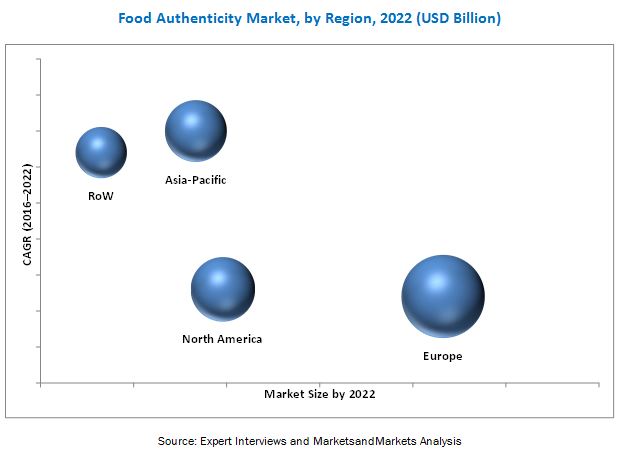The food authenticity testing market, in terms of value, is projected to reach USD 7.50 billion by 2022, at a CAGR of 7.6% from 2016 to 2022. The growing international trade is one of the factors driving this market as compels the manufacturers to comply with the global mandates and regulations for food authenticity due to the growing economically motivated adulterations (EMAs). As international trade increases complexities in the supply chain and the chances of cross-contamination and fraud, the demand for food authentication services is projected to remain high.

The objectives of the report:
- To define, segment, and project the size of the global food authenticity testing market on the basis of target testing, technology, and food tested
- To understand the structure of the food authenticity testing market by identifying its various subsegments
- To provide detailed information about the key factors influencing the growth of the market (drivers, restraints, opportunities, and industry-specific challenges)
- To strategically analyze micromarkets with respect to individual growth trends, future prospects, and their contribution to the total market
- To analyze the opportunities in the market for stakeholders and provide a competitive landscape of market trends
- To project the size of the market and its submarkets, in terms of value, with respect to four regions (along with their respective key countries)–North America, Europe, Asia-Pacific, and the Rest of the World (RoW)
Download PDF Brochure: https://www.marketsandmarkets.com/pdfdownloadNew.asp?id=157288822
The food authenticity testing market, based on target testing, is segmented as meat speciation, country of origin and aging, adulteration tests, and false labeling. The adulteration tests segment is projected to be largest, and the meat speciation segment is projected to be the fastest growing in the food authenticity testing market through 2022. The increasing number of food frauds due to the complexity of the supply chain also contributed to the market growth.
The food authenticity testing market, on the basis of technology, is segmented into PCR-based, LC-MS/MS, isotope methods, immunoassay-based, and others, which includes NMR spectroscopy, test kits, and chemical tests. The PCR-based technology witnesses an increased use in food authenticity testing. It is a molecular technique that uses DNA for the analysis of meat and food products, providing precise results on testing. The technology amplifies fragments of DNA extracted from the food product samples to accurately identify the DNA of each species in the product. This enables cross-checking of the product’s authenticity and confirmation of product claims. LC-MS/MS represents the second largest technology segment in the market. This technology is used to detect the authenticity in the food products as well. The testing market through PCR-based technologies is largely driven by its wide applicability, accurate determination of adulterant, meat species or GMO in products even at 0.1% levels of detection.
The food authenticity testing market, based on food tested, is categorized into meat & meat products, dairy & dairy products, processed foods, ingredients, cereals, grains, and pulses. The processed food segment is projected to be the largest segment, whereas the meat & meat products segment is projected to witness the fastest growth in the market. The growth of the processed food segment is attributed to a wide number of processing applications of products such as infant formula, packaged food, wine, and other processed food products. Due to the increasing fraud and counterfeit instances in processed food products, the demand for the food authentication testing services remains high in this segment. On account of these factors, the processed food segment is projected to be the largest in the food authenticity testing market.
Speak to Analyst: https://www.marketsandmarkets.com/speaktoanalystNew.asp?id=157288822
The Asia-Pacific region is projected to be the fastest-growing market through 2022 due to the increasing food safety concerns among the consumers and the growing market for processed food. France is projected to be fastest-growing country in the European region. European countries have recorded many issues related to food authenticity; as a result, stringent policies have been established to ensure complete food authenticity. Food safety authorities in Europe aim to protect consumer health by ensuring the quality of the food supply chain.
This report includes a study of marketing and development strategies, along with the product portfolios of leading companies. It includes the profiles of leading companies such as SGS SA (Switzerland), Intertek Group plc (U.K.), Eurofins Scientific (Luxembourg), ALS Limited (Australia), LGC Science Group Ltd (U.K.), Merieux Nutrisciences Corporation (U.S), Microbac Laboratories Inc. (U.S.), EMSL Analytical Inc. (U.S.), Romer Labs Diagnostic GmbH (Austria), and Genetic ID NA, Inc. (U.S.).
